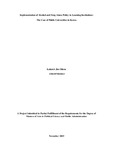| dc.description.abstract | This study assesses the implementation of alcohol and drug abuse policy in Kenya’s public
universities, and particularly examines the impact of resource availability, policy
communication, training and availability of screening tools on implementation process. The
study was guided by the following hypothesis; Resource availability influences
implementation of alcohol and drug abuse policy in Kenya’s learning institutions, Policy
communication influences implementation of alcohol and drug abuse policy in Kenya’s
learning institutions. Training and availability of screening tools influence implementation of
alcohol and drug abuse policy in Kenya’s learning institutions. The study collected both
qualitative and quantitative data in order to test the major independent variables: resources,
communication, training and screening tools hypothesized against the dependent variable:
implementation of alcohol and drug abuse policy. The results of this study show that 63.2%
of those interviewed state that resources was in sufficient. In addition to lack of resources,
descriptive analysis also revealed that 80.5% of the respondents indicated that there was lack
of personnel for the implementation of this policy.
The study also found out that the major communication mediums for this policy was
university website and notice boards, having been rated at 51.6% and 50.5% respectively.
However, despite the statistics showing that there was regular communication between
various service units, chi-square test indicated that policy communication had statistical
significance and thus influences the implementation process. Training and availability of
screening tools were also lacking in these universities. Inferential statistics also confirmed
through chi-square test that resources, training and availability of screening tools have a
significant effect on the implementation process. The study adopted the Contextual
Interaction Theory (CIT) of policy implementation. According to this theory for policy to be
successful resources, training and clear patterns of communication between actors must be
available. The study findings indicate there is lack of resources, training and screening tools.
The srtudy recommends sufficient allocation of resources for implementation process, ensure
there is training and provide screening tools to the implementing officers. | en_US |

